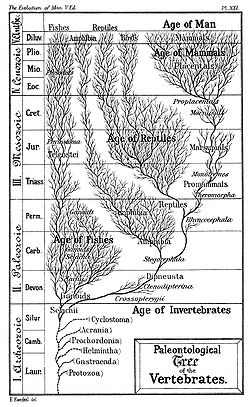Lactase persistence or lactose tolerance is the continued activity of the lactase enzyme in adulthood, allowing the digestion of lactose in milk. In most...
64 KB (7,417 words) - 13:17, 28 June 2025
the recent evolution of lactase persistence in some cultures, which extends lactose tolerance into adulthood. Lactase persistence evolved in several populations...
68 KB (7,039 words) - 06:18, 19 July 2025
lactose in breast milk or formula. Some population segments exhibit lactase persistence resulting from a mutation that is postulated to have occurred 5,000–10...
22 KB (2,101 words) - 17:09, 17 July 2025
Western Steppe Herders (section Lactase persistence)
had a frequency of over 25% of an allele that is associated with lactase persistence, conferring lactose tolerance into adulthood. Steppe-derived populations...
58 KB (6,356 words) - 06:47, 19 July 2025
History of North Africa (section Lactase Persistence)
Africa and the Near East, may have been the source population for lactase persistence variants, including –13910*T, and may have been subsequently supplanted...
63 KB (5,654 words) - 21:06, 23 June 2025
to contagious diseases (such as malaria), light skin, blue eyes, lactase persistence (or the ability to digest milk after weaning), lower blood pressure...
100 KB (11,720 words) - 20:33, 23 June 2025
tested. It has been hypothesized that an allele associated with lactase persistence (conferring lactose tolerance into adulthood) was brought to Europe...
70 KB (7,164 words) - 07:24, 22 June 2025
Polymorphism 13.9 kb Upstream of the Lactase Gene (LCT) (C−13.9kbT) Does Not Predict or Cause the Lactase-Persistence Phenotype in Africans". The American...
129 KB (13,268 words) - 13:57, 19 July 2025
hair, and dark or dark-to-black skin, with no genetic adaption for lactase persistence into adulthood. The near-complete skeleton, an adult male who probably...
23 KB (2,519 words) - 21:19, 19 July 2025
products. The ability for adult humans to digest milk relies on lactase persistence, so lactose intolerant individuals have trouble digesting lactose...
153 KB (15,811 words) - 15:06, 12 July 2025
lactose intolerance, and specifically the presence of the -13910T lactase persistence mutation, found in Europe and Central Asia, across South Asia. In...
240 KB (28,103 words) - 06:08, 19 July 2025
Ségurel, Laure; Bon, Céline (31 August 2017). "On the Evolution of Lactase Persistence in Humans". Annual Review of Genomics and Human Genetics. 18 (1):...
88 KB (3,512 words) - 08:45, 17 July 2025
East Asian types of ADH1B associated with rice domestication, or lactase persistence, are due to recent selection pressures. An even more recent adaptation...
116 KB (12,617 words) - 04:34, 21 July 2025
Genetic history of Africa (section Lactase persistence)
Africa and the Near East, may have been the source population for lactase persistence variants, including –13910*T, and may have been subsequently supplanted...
151 KB (16,174 words) - 22:31, 17 July 2025
world's highest frequencies of the R-L21 Y-chromosome haplotype and lactase persistence (the ability to digest milk into adulthood) are found among people...
100 KB (9,756 words) - 02:53, 22 July 2025
Swallow, Dallas M.; Thomas, Mark G. (2011-03-27). "Evolution of lactase persistence: an example of human niche construction". Philosophical Transactions...
28 KB (2,957 words) - 06:01, 29 June 2025
Allele age (section Lactase persistence)
condition known as lactase persistence. A study conducted by Sarah Tishkoff and her team shows that the mutation for lactase persistence has been under positive...
12 KB (1,583 words) - 11:36, 4 April 2024
Culture can profoundly influence gene frequencies in a population. Lactase persistence One of the best known examples is the prevalence of the genotype...
68 KB (8,251 words) - 17:51, 20 July 2025
on lactase persistence polymorphism of 23 elite and commoner samples from the 10-11th century found that their low prevalence of lactase persistence "corresponds...
112 KB (14,103 words) - 09:11, 15 July 2025
Sarah Tishkoff (section Lactase persistence)
three new single-nucleotide polymorphisms (SNPs) associated with lactase persistence (G/C-14010, T/G-13915 and C/G-13907) among ethnic groups in East...
36 KB (4,150 words) - 20:13, 8 November 2023
Africa and the Near East, may have been the source population for lactase persistence variants, including –13910*T, and may have been subsequently supplanted...
32 KB (3,550 words) - 13:51, 28 June 2025
Africa and the Middle East, may have been the source population for lactase persistence variants, including –13910*T, and may have been subsequently supplanted...
190 KB (21,026 words) - 04:02, 12 July 2025
moderate amounts of fructose and lactose, particularly if they have lactase persistence. A low-FODMAP diet consists of the global restriction of all fermentable...
23 KB (2,365 words) - 22:03, 17 July 2025
the selection pressure that led to the spread of alleles for adult lactase persistence. Analyses of the human genome have identified many hundreds of genes...
34 KB (3,769 words) - 01:53, 19 June 2025
of Indian and European Cattle Share their Predominant Allele for Lactase Persistence". Mol. Biol. Evol. 29 (1): 249–260. doi:10.1093/molbev/msr190. PMID 21836184...
188 KB (21,172 words) - 08:52, 17 July 2025
0132088. PMC 4503422. PMID 26176541. Cramer DW (November 1989). "Lactase persistence and milk consumption as determinants of ovarian cancer risk". American...
25 KB (2,412 words) - 17:22, 16 July 2025
extensively on the evolution of lactase persistence (see Lactose intolerance), the ability of some humans to produce the enzyme lactase throughout their adult...
10 KB (1,209 words) - 05:49, 20 July 2025
traits far more prevalent among people of Celtic ancestry include lactase persistence and red hair, with 46% of Irish and at least 36% of Highland Scots...
62 KB (6,567 words) - 22:24, 16 June 2025
as well as changes in metabolism due to changes in diet, such as lactase persistence. Culturally-driven evolution can defy the expectations of natural...
266 KB (26,511 words) - 03:42, 22 July 2025
European hunter-gatherers and surprisingly there was no evidence of lactase persistence at that period. The most recent samples, from the Iron Age, showed...
12 KB (1,215 words) - 14:20, 21 January 2025





















